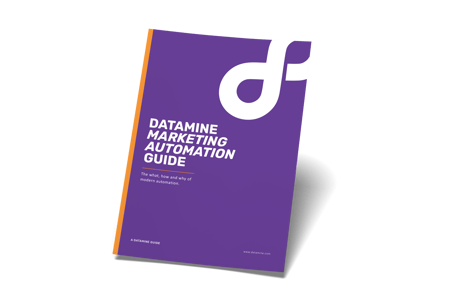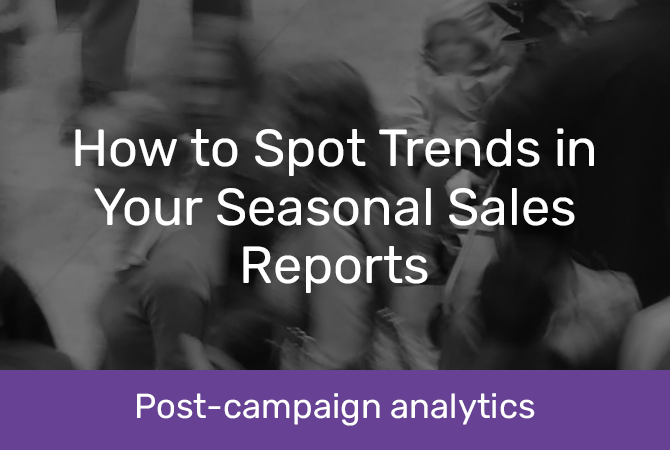
How to Spot Trends in Your Seasonal Sales Reports
Insights from post-campaign analysis
Black Friday, End of Season sales, and Boxing Day are times of massive bargains, super-charged marketing, and long hours. While the end of these sales periods feels like the hard yards are over, an enormous amount of data is waiting for you to use it.
With big sales seasons come big opportunities for growth – and loss. Your marketing team needs a way to turn the numbers in your seasonal sales reports into actionable insights and work out what went well and what details they may have missed.
Seasonal sales numbers are so high that any weaknesses in your seasonal campaigns have an outsized impact. That means it’s well worth doing a detailed post-campaign analysis so you’re fully prepared for the next sales season.
 prove your analytics count
prove your analytics count
Campaign analytics can involve ongoing tracking and testing during a campaign and a broader look at performance against campaign metrics after the fact. Plenty of analytics tools and techniques are available, which you can build into your marketing automation platform or source through providers like Google or Meta.
Analytics isn’t about placing blame or trashing a campaign – it’s about finding out what worked well and what the marketing team could do better next time. Every campaign is a chance to spot trends, identify what metrics your company does well in, and boost the next campaign’s ROI.
Sale season campaigns often go under or un-analysed. Sometimes, it’s a case of marketing teams running out of steam after a busy period or staff simply being out of the office over holiday periods. Whether it’s marketers or analysts doing the job, it’s worth ensuring you get the crucial marketing insights from these 3 areas.
3 crucial marketing insights from seasonal sales report analysis. Here’s what you can look for:
 1. Sales analytics
1. Sales analytics
When it's time to do a post-campaign analysis, look at the stats to see where your sales are coming from. Retail Metrics you could look at over the sales period include revenue, number of sales, how many customers were new or returning, the cost of customer acquisition, average sale price, and the best lead source.
Consumers interact with brands through an average of eight channels, and one in ten purchases happens through a non-traditional channel. Think social media, private "dark social" messaging platforms, sales marketplace, or even a smart speaker powered by Alexa or Google. If one channel – social, for example – seems to stand out, it’s worth showing this to the marketing teams so they can put more energy into that area in their next campaign.
Remember that just looking at the campaign metrics in isolation is not very helpful when reporting or measuring sales success. You must have a baseline or a trend to use as a comparison to make those numbers valuable.
It is also helpful to think about external factors to measure success. For instance, your internal trends might look okay, but how does that compare to competitors and broad industry trends? Are you keeping up with the market?
If your marketing teams are focused on pushing consumers only to your website, you could miss out on a significant portion of potential sales. Reporting and measurement are the best ways to identify your most robust buying channels and find growth opportunities.
 2. Email analytics
2. Email analytics
Email is underrated as a sales driver, offering the highest ROI of any channel (at around $36 for every $1 spent). During the holiday sales seasons, that impact can be even more substantial, with surveys showing that consumers pay more attention to sales emails around these times.
The challenge for campaign analysts is determining how to deliver an email that stands out. And the only way to know if your customers looked at your email is through analytics.
Look closely at the emails you sent – clicks, conversions, and A|B testing for different content. What type of email gets the best response? Is there a specific time or date that correlates with a sales boost? Could your marketing team send more emails to drive more sales? Or would sending fewer, shorter emails convey more value to your base?
Emails with personalised subject lines can increase open rates by 26% – do your marketing insights bear that out? Browsing data can help you personalise by consumer activity, while data collected in your CRM can help you personalise by name, area, and even prior purchases.
 3. Customer analytics
3. Customer analytics
Browsing isn’t just about searching for your brand – it’s about the consumer wandering around inside your website and, ideally, buying a product. This process isn’t necessarily straightforward – research shows that almost 70% of online shopping carts are abandoned before the sale is complete. That’s got to be frustrating for retailers.
On the other hand, those abandoned carts give you vital information about potential customers. Knowing the exact product a consumer wants to buy is like gold dust in marketing, so make sure you’re using it wisely. By combining this abandoned cart data with customer segmentation, you can provide the marketing teams with a better understanding of who they are targeting – including their drivers, motivations and demographics.
In your post-campaign analysis, abandoned carts and customer statistics should be part of the picture. What percentage of in-cart items are purchased vs abandoned? How well do you know your customers?
Data-driven Insights to forcast
Campaign analysis is a vital part of post-seasonal sales periods. While the stakes are higher and the details are more complex during this time, it’s essential to get it right.
Without a meticulous look at the outcomes of your campaign work, you could miss crucial details and opportunities to boost sales next time. With this information in hand, you can give your marketing teams precise data to get them thinking about when and how to start the next seasonal sales campaign. We're ready now to do your seasonal sales report analysis with you.
Data and appropriate analytics tools are the keys to building valuable seasonal sales reports. Without those, you won’t be able to gather the information you need, make connections between different data points, and turn those into valuable insights.
And that’s where Datamine comes in. We’re data devotees from way back, with decades of experience turning raw data into actionable information. To learn more about developing a data-driven marketing strategy, download our Datamine Guide to Marketing Automation below.
read More resources
If you want to learn more about campaign analysis, read the following blogs next:
The Datamine Guide to Marketing Automation
This guide walks you through the fundamentals of marketing automation. From what it is and who to buy it from to how to prepare for it, use it, and get the most out of it while you're learning the ropes. Finally, we lay out the fundamental things you can do today to both begin your marketing automation journey– and ensure it's a successful one.


















































